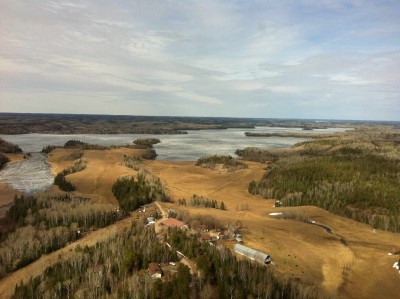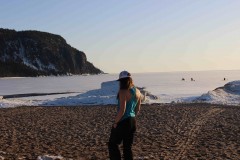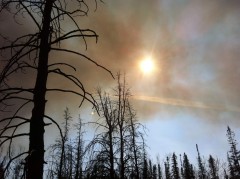 I grew up in the small town of Deep River, Ontario. 4200 people. Originally created to house employees of Atomic Energy of Canada Limited, I grew up with the narrow-minded impression that everyone would eventually become a doctor, engineer, technician, or researcher of some sort. Some might say (namely my parents) that I had a bit of stubborn bone; always striving to prove myself different from my siblings and peers. So when an employer suggested I look into forest fire fighting in northern Ontario for summer employment, I asked, where, when, and how much. The following summer, I was using Google maps to see where I had just agreed to move to and work in for the next four months; Kenora, Ontario.
I grew up in the small town of Deep River, Ontario. 4200 people. Originally created to house employees of Atomic Energy of Canada Limited, I grew up with the narrow-minded impression that everyone would eventually become a doctor, engineer, technician, or researcher of some sort. Some might say (namely my parents) that I had a bit of stubborn bone; always striving to prove myself different from my siblings and peers. So when an employer suggested I look into forest fire fighting in northern Ontario for summer employment, I asked, where, when, and how much. The following summer, I was using Google maps to see where I had just agreed to move to and work in for the next four months; Kenora, Ontario.

A permanent population of 16,000. One Walmart. Three grocery stores. A long history of various mills. One beautiful Lake of the Woods. And about a million gorgeous small lakes within a stones throw. With rock cuts on every part of the highway, cell phone reception was spotty at times. Locally owned and brewed coffee cost $2.75. And finding and buying a spaghetti squash was unlikely. Regardless, it was obvious that I was going to easily fall in love with “lake life.” It also became obvious that there was a lot of unspoken history; a lot that I wanted to know more about.
I was dispatched to my first fire before the end of my first week in Kenora. Basemap 36555—that’s all I knew. Small white smoke. Values to the west. Pumping distance: 200 ft. The radio chatter was overwhelming. Where were we going? How long will we be staying there for? As we flew over the community, I remember feeling confused. Seemingly unorganized dirt road-networks joined small houses with yards full of garbage and abandoned vehicles. The fire itself was right beside someone’s house…in their yard. Even after we landed, community members would drive, walk, or quad by, completely unfazed by the fact that four MNRF (Ministry of Natural Resources & Forestry) employees were suppressing a fire in their neighbour’s yard. Gangs of children biked by, wearing no helmets; isn’t this a school day? The home homeowner sat on her porch, and watched us working. This was an ordinary occurrence. This was no big deal. My crew leader told me to keep an eye on our jerry of gas; there were a couple curious people hanging around our pump site.  Why did I have to hang around the pump gas? Why did no one seemingly care about the fires on their properties? Why were there so many dogs running around the town? Was I missing something? A few other fires started nearby that day. Mainly grass fires. All human-caused fires. Basemap 36555 marks the First Nations community of Wabaseemoong, just northwest of Kenora. I soon learned to anticipate spending most of my springtime fire fighting in basemap 36555.
Why did I have to hang around the pump gas? Why did no one seemingly care about the fires on their properties? Why were there so many dogs running around the town? Was I missing something? A few other fires started nearby that day. Mainly grass fires. All human-caused fires. Basemap 36555 marks the First Nations community of Wabaseemoong, just northwest of Kenora. I soon learned to anticipate spending most of my springtime fire fighting in basemap 36555.
The summer months brought heat and cottagers. The population doubled, and the streets were filled with sun-kissed shoulders. And homeless people. There always seemed to be people hanging around outside the Laundromat, No Frills, and some of the government-owned housing. While the homeless population didn’t seem to faze locals, it wasn’t something that I associated with small towns. Alcohol and drug abuse was something that bad people did. Unemployment was a tragedy that was short-lived. Needle drugs were seen in movies. And residential schools were something that I might have heard about, once, somewhere, maybe. And yet here, in this beautiful, quaint, little town, there were always people, wandering the streets, or passed out in public spaces somewhere around the town. I often heard people playing it off as a joke—“Oh those are just the drunk natives.” It wasn’t something that I was accustomed to seeing in a small town. It was something that I had only ever associated with the downtown of big city centers. And it was never a joke. Online sources describe Kenora as the Muskoka of the north. But I knew there was more to the story that I was interested in learning about. I wanted to know why.
 I’ve spent three summers and one winter in Kenora, having worked at the bowling alley, the library, the high school, the pool, and of course, as a forest fire fighter for the MNRF in the summer months. I am constantly inquiring and learning the stories and histories from local First Nations residents from in and around the town. People from the nearby communities, Wabaseemoong, Grassy Narrows, Rat Portage, Shoal Lake, Whitefish Bay, and Sabeskong all bring forward different stories, different experiences, different explanations, though commonalities in historical events, racism, and inequities in available services persist, contributing to the continual tensions. From my time in Kenora, I’ve used the power of observation and inquiry to learn more about the First Nations communities living within the Treaty 3 district. It’s been a wild ride so far; one that I don’t anticipate ending anytime soon.
I’ve spent three summers and one winter in Kenora, having worked at the bowling alley, the library, the high school, the pool, and of course, as a forest fire fighter for the MNRF in the summer months. I am constantly inquiring and learning the stories and histories from local First Nations residents from in and around the town. People from the nearby communities, Wabaseemoong, Grassy Narrows, Rat Portage, Shoal Lake, Whitefish Bay, and Sabeskong all bring forward different stories, different experiences, different explanations, though commonalities in historical events, racism, and inequities in available services persist, contributing to the continual tensions. From my time in Kenora, I’ve used the power of observation and inquiry to learn more about the First Nations communities living within the Treaty 3 district. It’s been a wild ride so far; one that I don’t anticipate ending anytime soon.
Author Ariel Root is currently in Kenora in her fourth season working as a forest fire fighter for the Ontario Ministry of Natural Resources and Forestry. She has a BSc in Food Science & Nutrition from Carleton University in 2012, and is currently a graduate student in the Health Science, Technology and Policy program at Carleton University. She has been featured on APTN’s new hit TV show, Playing with Fire, Season 2.
Come back for next week’s instalment on homelessness.
Photos by Ariel Root
Follow us on twitter!